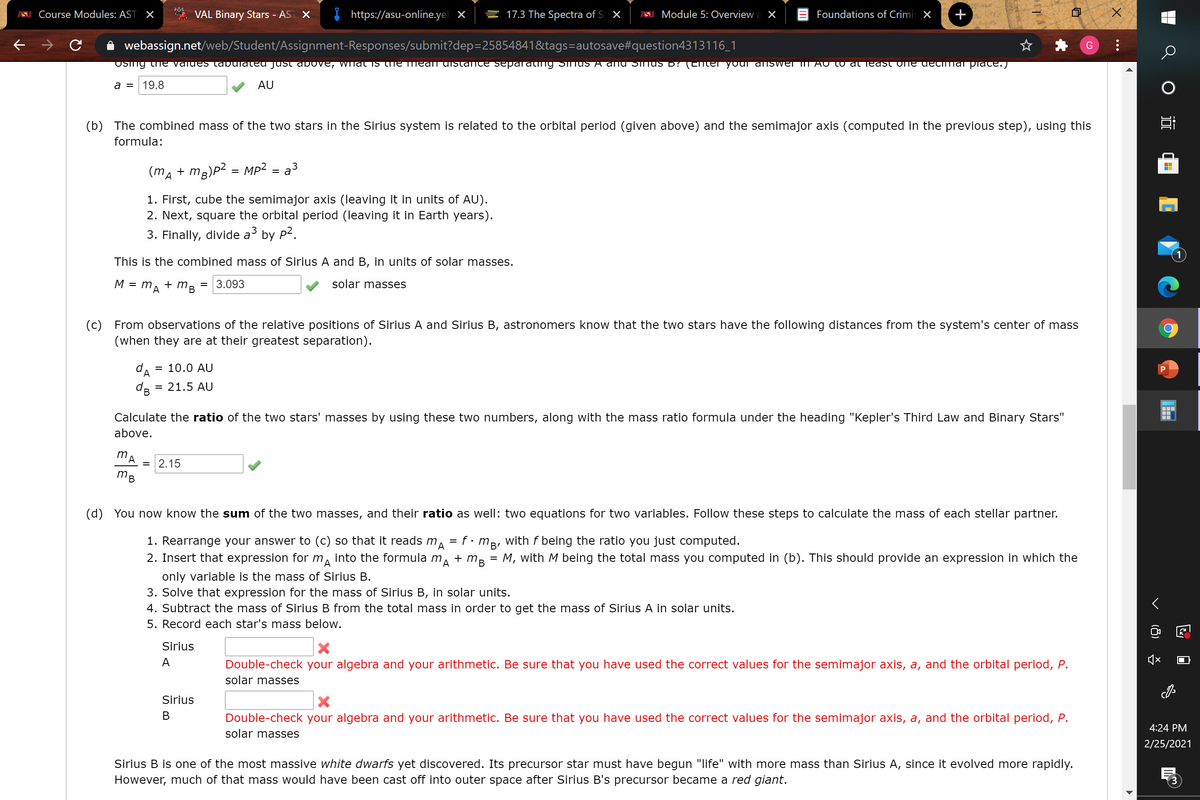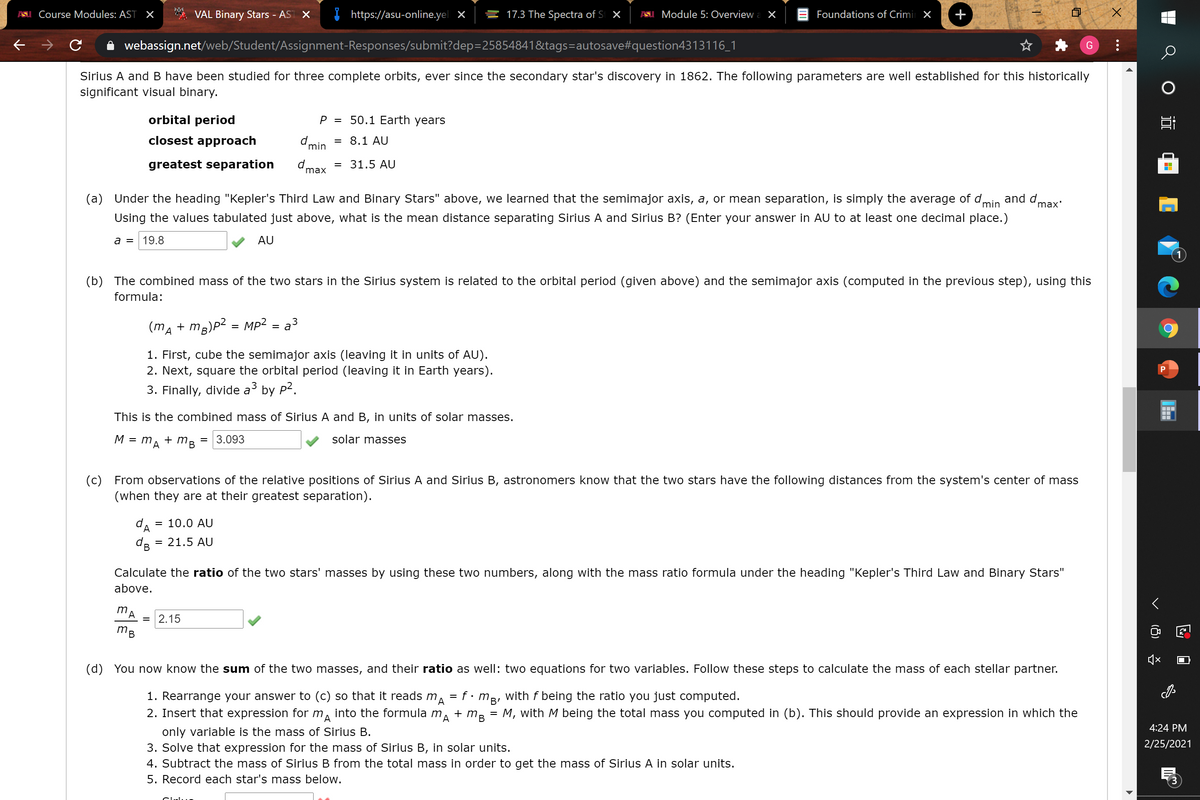(d) You now know the sum of the two masses, and their ratio as well: two equations for two variables. Follow these steps to calculate the mass of each stellar partner. 1. Rearrange your answer to (c) so that It reads m, = f. ma, with f being the ratio you just computed. 2. Insert that expression for m, Into the formula m, + ma = M, with M belng the total mass you computed in (b). This should provide an expression in which the only varlable is the mass of Sirius B. 3. Solve that expression for the mass of Sirius B, in solar units. 4. Subtract the mass of Sirius B from the total mass in order to get the mass of Sirius A in solar units. 5. Record each star's mass below. Sirius A Double-check your algebra and your arithmetic. Be sure that you have used the correct values for the semimajor axis, a, and the orbital period, P. solar masses Sirius B Double-check your algebra and your arithmetic. Be sure that you have used the correct values for the semimajor axis, a, and the orbital period, P. solar masses Sirius B is one of the most massive white dwarfs yet discovered. Its precursor star must have begun "life" with more mass than Sirlus A, since it evolved more rapidly. that mace ld have heen cast off Into outer enace after Sirlue R'e precureor became red giant Howey
(d) You now know the sum of the two masses, and their ratio as well: two equations for two variables. Follow these steps to calculate the mass of each stellar partner. 1. Rearrange your answer to (c) so that It reads m, = f. ma, with f being the ratio you just computed. 2. Insert that expression for m, Into the formula m, + ma = M, with M belng the total mass you computed in (b). This should provide an expression in which the only varlable is the mass of Sirius B. 3. Solve that expression for the mass of Sirius B, in solar units. 4. Subtract the mass of Sirius B from the total mass in order to get the mass of Sirius A in solar units. 5. Record each star's mass below. Sirius A Double-check your algebra and your arithmetic. Be sure that you have used the correct values for the semimajor axis, a, and the orbital period, P. solar masses Sirius B Double-check your algebra and your arithmetic. Be sure that you have used the correct values for the semimajor axis, a, and the orbital period, P. solar masses Sirius B is one of the most massive white dwarfs yet discovered. Its precursor star must have begun "life" with more mass than Sirlus A, since it evolved more rapidly. that mace ld have heen cast off Into outer enace after Sirlue R'e precureor became red giant Howey
Stars and Galaxies (MindTap Course List)
10th Edition
ISBN:9781337399944
Author:Michael A. Seeds
Publisher:Michael A. Seeds
Chapter11: The Formation And Structure Of Stars
Section: Chapter Questions
Problem 10P
Related questions
Question
100%
I don't understand how to solve for (d) and need some help understanding the equation.

Transcribed Image Text:ASI Course Modules: AST X
VAL Binary Stars - AST X
I https://asu-online.yel x
I 17.3 The Spectra of St X
ASI Module 5: Overview a ×
Foundations of Crimin X
+
webassign.net/web/Student/Assignment-Responses/submit?dep=25854841&tags=autosave#question4313116_1
G
USIng thE values labulateu just aboVe, wilal IS the mtali distaICE SEpaating SITUS A dnd Sinus b? (Citel youi aisVEI IT AU T0 at ledst ofne deCImal piaCE.)
a = | 19.8
AU
(b) The combined mass of the two stars in the Sirius system is related to the orbital period (given above) and the semimajor axis (computed in the previous step), using this
formula:
(mA + mg)P2 = MP²
a3
1. First, cube the semimajor axis (leaving it in units of AU).
2. Next, square the orbital period (leaving it in Earth years).
3. Finally, divide a by p2.
This is the combined mass of Sirius A and B, in units of solar masses.
М — т
+ m
= 3.093
solar masses
(c) From observations of the relative positions of Sirius A and Sirius B, astronomers know that the two stars have the following distances from the system's center of mass
(when they are at their greatest separation).
= 10.0 AU
d3 =
= 21.5 AU
Calculate the ratio of the two stars' masses by using these two numbers, along with the mass ratio formula under the heading "Kepler's Third Law and Binary Stars"
above.
= 2.15
mB
(d) You now know the sum of the two masses, and their ratio as well: two equations for two variables. Follow these steps to calculate the mass of each stellar partner.
mB, with f being the ratio you just computed.
M, with M being the total mass you computed in (b). This should provide an expression in which the
1. Rearrange your answer to (c) so that it reads m,
= f•
2. Insert that expression for m, into the formula m,
+ mB
only variable is the mass of Sirius B.
3. Solve that expression for the mass of Sirius B, in solar units.
4. Subtract the mass of Sirius B from the total mass in order to get the mass of Sirius A in solar units.
5. Record each star's mass below.
Sirius
A
Double-check your algebra and your arithmetic. Be sure that you have used the correct values for the semimajor axis, a, and the orbital period, P.
solar masses
Sirius
В
Double-check your algebra and your arithmetic. Be sure that you have used the correct values for the semimajor axis, a, and the orbital period, P.
4:24 PM
solar masses
2/25/2021
Sirius B is one of the most massive white dwarfs yet discovered. Its precursor star must have begun "life" with more mass than Sirius A, since it evolved more rapidly.
However, much of that mass would have been cast off into outer space after Sirius B's precursor became a red giant.
(8)
...

Transcribed Image Text:ASI Course Modules: AST X
VAL Binary Stars - AST X
I https://asu-online.yel x
I 17.3 The Spectra of Si X
ASI Module 5: Overview a ×
Foundations of Crimin X
+
webassign.net/web/Student/Assignment-Responses/submit?dep=25854841&tags=autosave#question4313116_1
G
Sirius A and B have been studied for three complete orbits, ever since the secondary star's discovery in 1862. The following parameters are well established for this historically
significant visual binary.
orbital period
P = 50.1 Earth years
closest approach
d min
8.1 AU
greatest separation
d.
max
= 31.5 AU
(a) Under the heading "Kepler's Third Law and Binary Stars" above, we learned that the semimajor axis, a, or mean separation, is simply the average of d and dmax:
min
Using the values tabulated just above, what is the mean distance separating Sirius A and Sirius B? (Enter your answer in AU to at least one decimal place.)
a = | 19.8
AU
(b) The combined mass of the two stars in the Sirius system is related to the orbital period (given above) and the semimajor axis (computed in the previous step), using this
formula:
(ma + mg)P2 = MP² = a³
%D
1. First, cube the semimajor axis (leaving it in units of AU).
2. Next, square the orbital period (leaving it in Earth years).
3. Finally, divide a by p2.
This is the combined mass of Sirius A and B, in units of solar masses.
M = mA
= 3.093
solar masses
+
mB
%D
(c) From observations of the relative positions of Sirius A and Sirius B, astronomers know that the two stars have the following distances from the system's center of mass
(when they are at their greatest separation).
dA
= 10.0 AU
= 21.5 AU
Calculate the ratio of the two stars' masses by using these two numbers, along with the mass ratio formula under the heading "Kepler's Third Law and Binary Stars"
above.
m
А
2.15
(d) You now know the sum of the two masses, and their ratio as well: two equations for two variables. Follow these steps to calculate the mass of each stellar partner.
1. Rearrange your answer to (c) so that it reads m, = f•mB, with f being the ratio you just computed.
2. Insert that expression for ma
into the formula ma
+ m3 = M, with M being the total mass you computed in (b). This should provide an expression in which the
%3D
4:24 PM
only variable is the mass of Sirius B.
3. Solve that expression for the mass of Sirius B, in solar units.
4. Subtract the mass of Sirius B from the total mass in order to get the mass of Sirius A in solar units.
5. Record each star's mass below.
2/25/2021
(8)
Expert Solution
Step 1
Given,

Trending now
This is a popular solution!
Step by step
Solved in 2 steps with 2 images

Knowledge Booster
Learn more about
Need a deep-dive on the concept behind this application? Look no further. Learn more about this topic, physics and related others by exploring similar questions and additional content below.Recommended textbooks for you

Stars and Galaxies (MindTap Course List)
Physics
ISBN:
9781337399944
Author:
Michael A. Seeds
Publisher:
Cengage Learning

Foundations of Astronomy (MindTap Course List)
Physics
ISBN:
9781337399920
Author:
Michael A. Seeds, Dana Backman
Publisher:
Cengage Learning

Astronomy
Physics
ISBN:
9781938168284
Author:
Andrew Fraknoi; David Morrison; Sidney C. Wolff
Publisher:
OpenStax

Stars and Galaxies (MindTap Course List)
Physics
ISBN:
9781337399944
Author:
Michael A. Seeds
Publisher:
Cengage Learning

Foundations of Astronomy (MindTap Course List)
Physics
ISBN:
9781337399920
Author:
Michael A. Seeds, Dana Backman
Publisher:
Cengage Learning

Astronomy
Physics
ISBN:
9781938168284
Author:
Andrew Fraknoi; David Morrison; Sidney C. Wolff
Publisher:
OpenStax

Horizons: Exploring the Universe (MindTap Course …
Physics
ISBN:
9781305960961
Author:
Michael A. Seeds, Dana Backman
Publisher:
Cengage Learning


Stars and Galaxies
Physics
ISBN:
9781305120785
Author:
Michael A. Seeds, Dana Backman
Publisher:
Cengage Learning